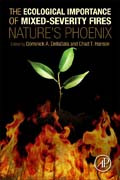
The Ecological Importance of Mixed-Severity Fires: Natures Phoenix
DellaSala, Dominick A
Hanson, Chad T.
The Ecological Importance of Mixed-Severity Fires, presents needed information on the current paradigm shift to move beyond fear-based fire suppression responses to appropriate use of wildland fires, including severe ones, in maintaining pyro-diversity. While much of the current forest management in fire-adapted ecosystems, especially forests, is focused on fire prevention and suppression, recent fire ecology science shows that mixed- and high-severity fires produce unique biological pulses on par with the richness of much heralded old-growth forests and threatened by intensive pre- and post-fire suppression. Little has been presented in previous books on the importance of mixed- and high-severity fire with regard to the maintenance of native biodiversity and fire-dependent ecosystems and species, and this text fills that void. While it focuses mostly on montane forests of the western United States, it also includes case studies written by more than 25 of the world's foremost fire ecologists of fire-dependent grasslands, chaparral, and forests from Central Europe, South-eastern Australia, boreal Canada, and sub-Sahara Africa to offer a global perspective. Offers the first reference written on mixed- and high-severity fires and their relevance for biodiversity Contains a broad synthesis of the ecology of mixed- and high-severity fires covering such topics as vegetation, birds, mammals, insects, aquatics, and management actions Explores the conservation vs. public controversy issues around megafires in a rapidly warming world INDICE: Preface Section I: Biodiversity of Mixed- and High-Severity Fires 1. Setting the Stage for Mixed- and High-Severity Fires 2. Ecological and Biodiversity Benefits of Mega-Fires 3. Using Bird Ecology to Learn about the Benefits of Severe Fire 4. Mammal Habitat Selection in Mixed- and High-Severity Fires 5. Stream-Riparian Ecosystems of Mixed- and High-Severity Fires 6. Bark Beetles and Mixed- and High-Severity Fires in Rocky Mountain Subalpine Forests Section 2: Global Perspectives on Mixed- and High-Severity Fires 7. High-Severity Fire in Chaparral: Cognitive Dissonance in the Shrublands 8. Regional Case Studies of Mixed-Severity Fires: South-East Australia, Sub-Saharan Africa, Central Europe, and Boreal Canada 9. Climate Change and Mixed- and High-Severity Fires: Uncertainties, Shifting Baselines, and Fire Management 10. Carbon Dynamics of Mixed- and High-Severity Wildfires: Pyrogenic CO2 Emissions, Post-fire Carbon Balance, and Succession Section 3: Managing Mixed- and High-Severity Fires 11. In the Aftermath of Mixed- and High-Severity Fire: Logging and Related Actions Degrade Mixed and High-Severity Burn Areas 12. The Rising Costs of Wildfire Suppression and the Case for Ecological Fire Use 13. Flight of the Phoenix: Coexisting with Mixed-Severity Fires
- ISBN: 978-0-12-802749-3
- Editorial: Elsevier
- Encuadernacion: Rústica
- Páginas: 352
- Fecha Publicación: 01/07/2015
- Nº Volúmenes: 1
- Idioma: Inglés
